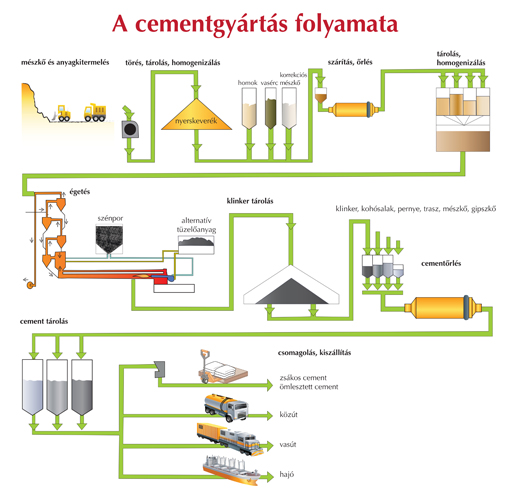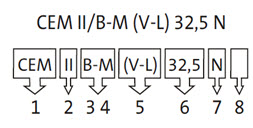Cement
A brief history of cement production
Process of cement production
Characteristics and composition of cement
Cement types
Facts, information and curiosities about cement production
Cement is a hydraulic inorganic binder which is essential for the construction industry. It is a grey powder which hardens after mixing with water or through chemical processes, and keeps this characteristic underwater as well.
A brief history of cement production
Around the 3rd century BC the Romans used a binder called “opus caementitium” in construction, which was made up of rubbles of varying size, pozzolana and brick sand, sand and quicklime.
The rediscovery of cement is dated around the end of the 18th century. In 1791 with his research related to the production of hydraulic lime John Smeaton created the basis for future cement production. In 1796 James Parker patented the hydraulic-setting “Roman cement”. About 30 years later, in 1824, Joseph Aspdin, a Leeds mason, patented a cement manufacture method during which he mixed burned lime and lime hydrate with a certain amount of clay, then added water and calcinated it until the carbonic acid entirely expelled. Aspdin called the product “Portland cement” because its colour resembled the colour of the cliffs of the Portland peninsula. His son, William Aspdin, perfected the manufacture of Roman cement and some sources consider him the inventor of Portland cement.
However, the Portland cement we know today was only made first in 1844 by J.C. Johnson, who calcinated the lime-clay mixture until it shrinks.
The first cement plant in Hungary was established by Balázs Konkoly Thege in Lábatlan in 1868, where Roman cement was made in a wood-fuelled 16 chamber furnace.
Up
Process of cement production
The modern cement production uses available innovative technologies during the exploitation of lime stone, the grounding of raw materials, the burning of clinker, and the grounding of cement.
Exploitation
The first step of cement production is the exploitation of the raw material. The clay and limestone are stripped by explosives, and the exploitation is performed by wheel loaders and excavators.
Limestone and clay crushing
The stripped stone and the exploited clay is crushed, shredded, homogenised and then their chemical compound is established.
Raw material pulverization
The prepared raw material mixture is taken to ball and roller mills, where it is pulverized to a fine powder.
Clinker burning
The fine powder of raw material mixture is calcinated. In the heat exchanger the hot flue emanating from the rotary kiln is already heating the kilndust advancing through the counter current, and thus the chemical processes begin: the kilndust is burned in a temperature (around 1450 °C) where it shrinks and melts. By the end of the technologic process the chemical reactions will have transpired, during which the chemicals (so called clinker minerals) are formed which possess the characteristics of cement.
Cement grinding
The burned semi-finished product, clinker, is then stored after quick cooling. Cement is made by the joint grinding of clinker, 4-5% binding regulator (gypsum stone, REA plaster), and other additives (granulated blast furnace, fly ash, tuff, clean limestone). During the process it is important to regularly monitor the quality of the cement, which is made by state-of-the-art laboratory technology equipment.
Storing, packaging, delivery
The different quality (by strength grade 52.5; 42.5; 32.5 MPa) and composition cements in storage are delivered by custom demand. It is delivered in auto-packaged 25kg bags or in bulk form.
Cements – inherently – are moisture-sensitive.
The full exclusion of moisture is practically impossible. Due to this fact strength decline may be experienced even after three months of dry storage.

Up
Characteristics and composition of cement
Cement is made up by main and minor additional constituents. Main constituents are clinker and hydraulites (additives), minor additionak constituents are main constituent hydraulites dosed up to 5% or other inorganic materials. The main minor additional constituents in cement production are the following:
- granulated blast furnace
- fly ash
- pozzolana, tuff
- limestone

1. Cement sign: CEM
2. Cement type signs I-V:
I. Portland cement
II. Portland-composite cement
III. Blast furnace cement
IV. Pozzolanic cement
V. Composite cement
3. Indication of the amount of main constituents:
A,B,C
CEM II „A” 6-20%;
CEM II „B” 21-35%;
CEM III „A” 36-65%
CEM III „B” 66-80%
CEM III „C” 81-95%
CEM IV „A” 11-35%;
CEM IV „B” 36-55%;
CEM V „A” 36-60%
CEM V „B” 62-80%
4. Indication of main constituents in addition to clinker (K):
V – siliceous fly ash
S – granulated blast furnace
P – natural pozzolana (tuff)
L/LL – limestone
M – composite cement (2 or more main constituent in addition to clinker)
5. indications for the quality of main constituents in case of composite, portland, blast furnace, pozzolana and composite cements in addition to clinker (K): V, S, P, L/LL
6. The lower characteristic value of 28-day compressive strength (MPa)
7. Indication of strength:
N – normal early strength cement
L – low early strength cement
R – rapid early strength cement
32.5, 42.5, 52.5 – classification by strength grade (28 day)
8. Indication fo sulfate resistance:
Szulfate resistance:
MSR – moderate sulfate-resistant
SR – sulfate resistant
Low heat generation
LH – low heat generation
Up
Cement types
Portland cement
Portland cement is a hydraulic binder, which is created by the calcination of a pre-determined raw material mixture in shrinking temperature. After its subsequent pulverization it is mixed with water and as a result of the hydration processes, hardens. It is a stone-like, not water-soluble, stable formation. In addition to Portland clinker and binding regulating materials Portland cements can only contain up to 5% of minor additional constituents.
Portland-composite cement
The group of Portland-composite cements consist of cements containing 65-95% clinker and 5-35% hydraulite. They are called that because of the added hydraulite constituent. E.g.: fly ash Portland cement, blast furnace Portland cement, etc.
Blast furnace cement
Blast furnace cements contain 5-65% clinker and 36-95% granulated blast furnace.
Pozzolanic cement
Pozzolanic cements contain 45-89% clinker and 36-55% material(s) with pozzolanic characteristics.
Composite cement
Composite cement contain 20-64% clinker, 18-49% blast furnace, and 18-49% material(s) with pozzolanic characteristics.
Up



